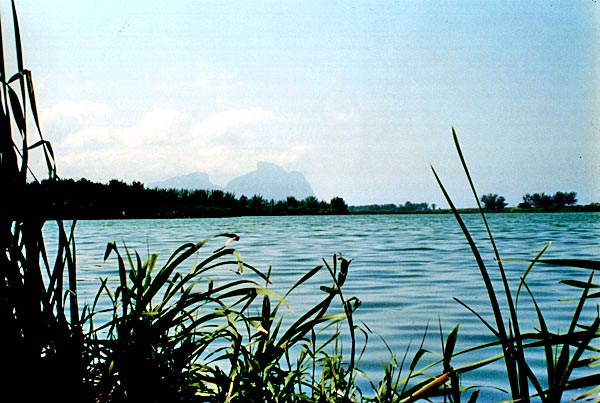 |

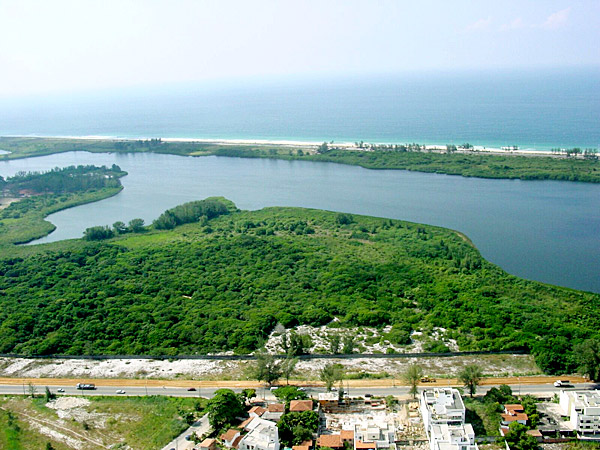 |
During
the year of 2003, a group of young researchers who study the Orchidaceae
family, did a work which covered the Area of Environmental Protection
of de Marapendi - APA Marapendi, placed in Rio de Janeiro city. Melisa Bocayuva, Eduardo Saddi and Carlo Alberto Zaldini, under the orientation of Cláudio Nicoletti Fraga, paid monthly visits to this habitat in order to do a survey of the Orchidaceae flora. They verified the occurrence of 8 species, 7 are terrestrial and just one semi-epiphyte. The result of this work has been presented, under a form of panel, during the International Orchid Conservation Congress - IOCC II, which took place in 2004, in Sarasota, Florida, at the Marie Selby Botanical Gardens. Before that, during 2002, Eduardo Saddi has already did a research in the same place in order to |
| complete his studies in the area of Environment Interpretation in a more generalized approach. | |
APA Marapendi - An area of sandbank (restinga) Creation, Geographical Characteristics - Localization and Anthropical Occupation Inside the geography of Brazil, the littoral quaternary plain (restinga or sandbank) occupies an extension at about 5.000 km, in a total of 9.000 km in the Brazilian littoral. In the state of Rio de Janeiro, the restingas occupy an area at about 1.200 km2, it means, 2,8 % of the total area of the state (Araujo & Maciel, 1998). Inside the domains of Rio de Janeiro city, they were the vegetal covering which, proportionally to their area, had the most high rates of reduction (30% of loss)), in the second part of the 80th decade and all 90 yeas. The creation of APA Marapendi Inside an area of restinga, in the Baixada of Jacarepaguá (lowlands), in 1991, the Area of Environmental Protection – APA – Marapendi (Área de Proteção Ambiental de Marapendi) has been created. Besides the lagoon and Marapendi Channel, it also comprehends the sand strip between the lagoon and the ocean and the surrounding areas, encircling an extension of 9.700 Km2. This creation was linked to environmental community movements. Anthropical Occupation The story of the occupation of the Baixada de Jacarepaguá returns to the cycle of the sugar-cane when this area was used for this culture. After this period, the lack of intensive use for almost a century allowed the natural regeneration of the great part of the vegetal covering. However, the construction of the highway Lagoa-Barra intensified the urbanization of the restingas in this region, which provoked great losses to the ecosystem surrounding the Marapendi lagoon, as well as to the other lagoons enclosed in the same hydrographic basin of Jacarepaguá (Jacarepaguá, Camorim, Tijuca Lagoinha). The indiscriminate pouring out of the sewer and the litter in their water is a menace for their bio-diversity. Environmental Characteristics The APA-MARAPENDI represents an anthropogenic fragment of restinga, however, due to reduction of the vegetal covering already mentioned, it serves as a relevant shelter for the wild life concerning the study and the handling in the city's domains. It has a characteristic vegetation of restinga with varied phytophysiognomies, presenting a restinga-wood with big trees and a open formation with bushes. Some remains of its original wood can be found, such as Tabebuia cassinoides, species which is a threatened of extinction. Another interesting occurrence is the present of pioneer trees, such as Joannesia princeps and the great number of lianas which shows that the wood is in regeneration. As it is not a continuous fragment, the collections have been done in different fragments. Some species have been seen in all fragments and others, no, but it doesn't mean that they do not occur or that their populations are being reduced. The dynamic of the populations of those species in this area is not known. Development of the Research The research has been done by monthly collecting all around 2003. Every botanical fertilized material has been herborized and later deposited in the Herbarium RB. Vegetative materials were also collected for the formation of germoplasme bank and have been inserted in the Alive Collection of the Botanical Garden of Rio de Janeiro, in the greenhouse of the Orchidaceae. Until this moment, the area presents 7 terrestrial species and one semi-epiphyte (Vanilla bahiana Hoehne). No epiphytic species has been seen and this means that the area suffered an accentuated extraction before became an unity of conservation, what propitiated the possibility of being used as a model for re-introduction projects of the species and handling of populations. |
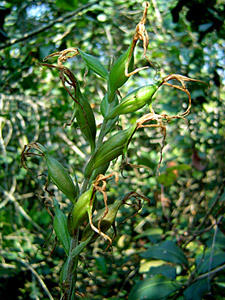 fruit |
Among
the species represented in the area, Eltroplectris calcarata (Sw.) Garay & Sweet is threatened of extinction in the region of Rio de Janeiro city. |
| Habitat |
| They occur always in very well shaded place in a thick layer of organic material, mainly the species of Eltroplectris Rafinesque and Prescottia Lindl. The other are found in another conditions such as a thin layer of organic material or even direct on the sand. |
| Species |
| Cyrtopodium polyphyllum (Vell.) Pabst ex F. Barros | |
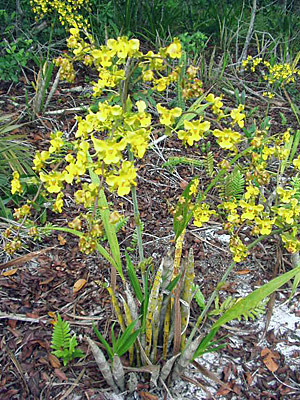 |
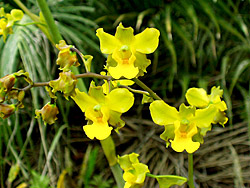 This species occurs in great populations in the different fragments visited, being observed in strongly exposed to sunlight as well as in inside the bushes protected by the crows of the trees. Concerning the substrate, they grow in thick layers of organic material as well as directly in the sand. It is common to see populations abundantly flowered and also with fructification. The habitat seems to be a good remaining area for this species. |
| Epidendrum denticulatum Barb. Rodr. | |
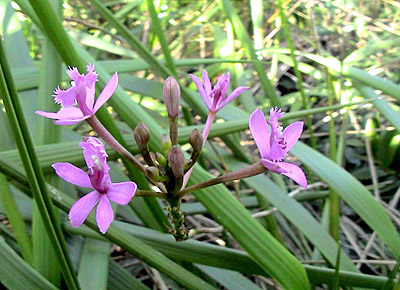 |
Like
Cyrtopodium polyphyllum, this species is also seen all
along the APA, occurring in different places, different intensity of
luminosity and different substrates. Also for this species, the area
seems to be a good remaining for this species. Plants with fructification have been seen. |
| Eltroplectris Rafinesque | ||
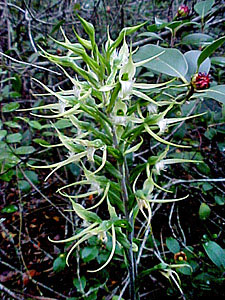 Eltroplectris calcarata |
Genus
represented by two species: Eltroplectris calcarata (Sw.) Garay
& Sweet and Eltroplectris triloba (Lindl) Pabst. Both species have been seen in different fragments, in very similar conditions always occurring in very well shady places, over a layer of organic material in decomposition. Many specimens have been found only in their vegetative form however, they seem to be well distributed all along the APA. Fructifying populations have been observed. |
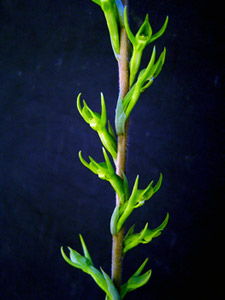 Eltroplectris triloba |
| Prescottia Lindl. | ||
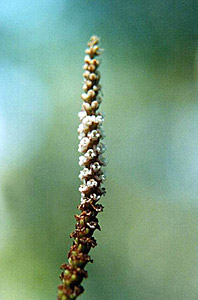 |
Genus also represented by two species, P. oligantha (Sw.) Lindl. and P. plantaginea Lindl. The few individuals found of both species were found in just one fragments of the APA. Just five specimens of the first one have been observed. They occur in the same conditions as the species of Eltroplectris and were also found fructifying well in this place. |
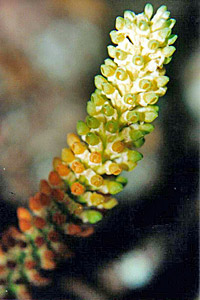 |
| Oeceoclades maculata (Lind.) Lindl. | |
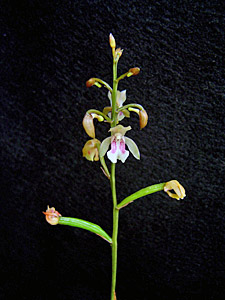 |
appears,
very often, all along the APA in different fragments. It occurs, preferentially in shady places. It bloom and fructifying well in the region. |
Vanilla bahiana Hoehne |
||
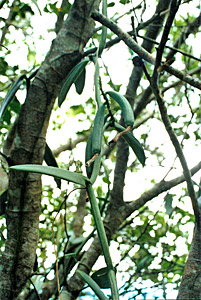 |
Species
also found in different fragments occurring in the interior of the bushes,
where plants are protected from the sunlight, however, it is quite common
observe its passage from one bush for another, crawling over the ground,
exposed to strong luminosity. The blooming occurs inside the bushes
and also the fructification. |
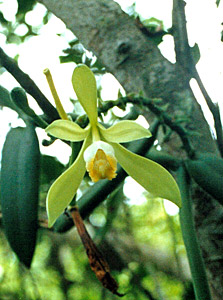 |
List of the
species found with calendar of blooming
| Mar | April | May | Jun | Jul | Aug | Sept | Oct | Nov | Dec | |
| Cyrtopodium polyphyllum (Vell.) Pabst ex F. Barros | ||||||||||
| Epidendrum denticulatum Barb. Rodr. | ||||||||||
| Eltroplectris calcarata (Sw.) Garay & H.R. Sweet | ||||||||||
| Eltroplectris triloba (Lindl.) Pabst | ||||||||||
| Prescottia oligantha (Sw.) Lindl. | ||||||||||
| Prescottia plantaginea Lindl. | ||||||||||
| Oeceoclades maculata (Lindl.) Lindl. | ||||||||||
| Vanilla bahiana Hoehne |
|
Researchers: Melissa F. Bocayuva Cunha - Getting her Master at The National School of Tropical Botany (Botanical Garden of Rio de Janeiro). Eduardo Saddi - Bachelor of Vegetal Biology at the Federal University of Rio de Janeiro - UFRJ. Carlo Alberto Zaldini - Biologist ( University of Santa Úrsula - RJ) Supervised by: Cláudio Nicoletti Fraga, botanist, trustee of the alive collections of Botanical Garden of Rio de Janeiro |
